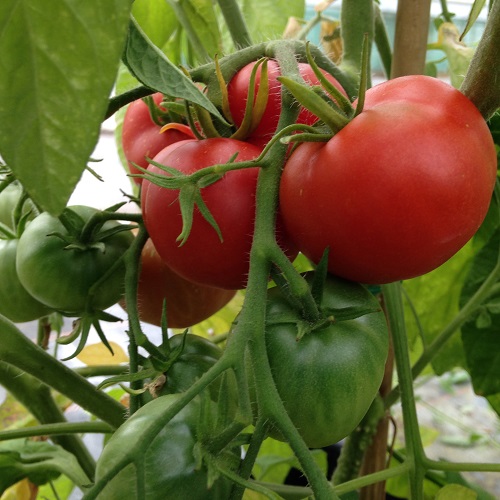What is Potato Blight?
Sometimes known as late blight, potato blight is a fungal type organism (Phytophthora infestans) that can have a devastating effect on the leaves, stems and tubers of both the potato and outdoor tomato plants, rendering the fruits and tubers inedible. Potatoes and tomatoes are both members of the same genus (Solanum), which makes them equally vulnerable although tomatoes grown under glass are much less likely to be affected. Potatoes however, are very susceptible to the disease, which can spread rapidly over long distances. There is no safe chemical or biological treatment and therefore foliage of infected plants is best removed immediately and burned rather than composted.
Potato blight was responsible for the great famine in Ireland between 1845 and 1849, during which time around 1 million people died of starvation. Potato blight ravaged crops all over Europe in the 1840’s but in Ireland around 30% of the population depended entirely on this crop for food, due to various different reasons. Potato blight has never been totally eradicated and outbreaks are reported in various regions of the UK every year. It is particularly prevalent during wet summer months.
Blight can start and spread from anywhere but it is known to be a risk wherever temperatures are warm and damp over a period of two consecutive days. This was, and still is still known as the Smith Period, although recent developments have now suggested there are other criteria to be considered. The new term is now known as the ‘Hutton Criteria’, which takes into account a reduction in the humidity threshold needed to start an infection.
How Does Potato Blight Spread?
The fungus-like organism is microscopic and consists of spore-bearing structures (sporangia), which are dispersed and spread by the wind. Hence the reason why the disease can spread rapidly so far and wide. The fungus is most prevalent in humid weather conditions during the late summer months, often before the main crop is ready for harvesting. When a fungus spore comes into contact with a wet or damp potato plant leaf, it will quickly produce zoospores, known as ‘swarmers’. These minute organisms will quickly spread out over the surface of the leaves and invade the plant tissue.
Within 3 days from the initial infection, new spores are formed, which can then be carried by the wind onto other parts of the plant or other previously unaffected plants. The cycle then continues relentlessly and infection spreads very quickly, engulfing the whole crop and infecting plants much further afield. The reasons why infections are worst during long wet summers is because the sporangia organism needs moisture in order to move around and multiply. Plants should therefore be checked regularly and all infected leaves and stems must be removed and burned to prevent further spread.
Blight can over winter in infected seed potatoes and in diseased potatoes, which have been left in the ground after harvesting. It can also spread from infected leaves and stems, which have been placed on compost heaps or those, which have simply been discarded and left lying around the growing areas. Good hygiene is absolutely paramount when dealing with infected parts of plants with burning considered to be the most effective measure. The tubers of infected plants may be fine if harvested before the outbreak becomes severe. However, as a precaution it is best practice to ensure all tubers from infected plants are removed from the soil and stored in a cool dry place. Any tubers that may be infected will rot during storage so a regular check is advisable.
Symptoms, prevention and control
During warm, humid weather from June onwards, the blight pathogen can spread freely with symptoms being easily recognisable. On the upper part of leaves and on stems, black spots will at first appear. Generally these lesions will appear on the leaf margins and then spread inwards over the entire leaf. There is sometimes a ring of light green tissue surrounding the infection with a white downy growth on the underside of the leaf. This downy growth is the result of millions of new spores, which can take to the wind and infect neighbouring crops. Once infection takes hold, each infected leaf can die within a few days.
Preventative measures include ‘chitting’ seed potatoes, which simply means encouraging them to sprout so that they get a good early start. This can be done by exposing the seed potatoes to light and heat. Young shoots are particularly vulnerable to attack so chitting can help avoid early infection. It is also a good idea to ensure young plants are watered at the base rather than wetting the foliage. Applying a mulch at the early stages of growth is also recommended. Check plant leaves regularly and remove if any are showing signs of suspected infection. Early potatoes are much less likely to succumb to infection so this option might be best considered, especially in areas where blight is known to be prevalent. To ensure seed potatoes are disease free, always buy certified stock from a reputable merchant.
Removing infected leaves and stems immediately is highly recommended to prevent the spores from washing down onto lower leaves and branches and into the soil, where the tubers can also become infected. Earthing up main crop potatoes can offer some immediate protection but crop rotation is also a good preventative measure in the long term. There is no fungicidal treatment available to control potato blight as all previous chemicals used to treat the condition have now been banned for either health or for legal reasons. Vigilance and good crop management are the only effective control of this disease.
Further preventative measures and recommendations
Potato blight is a difficult disease and can be very time-consuming to control, so prevention will always be better than cure. One option, which will help to avoid any blight infection is to grow early and second early potatoes. Blight is more often associated with main crop potatoes, which take longer to mature and are therefore at the mercy of any wet summer periods, in which blight infection could be a problem.
Also, early potatoes can be grown successfully in bags or large containers reducing any risk of spreading possible soil borne diseases. Some recommended early potatoes are Arran Pilot, Pentland Javelin, Rocket and Duke of York. Second early potato varieties include Charlotte, Kestrel and Vivaldi amongst several others.
Good hygiene and crop management will definitely help reduce any risk and alleviate the spread of any infection. Management could include careful watering of plants especially during the early growing period. It’s always best to water the soil at the base of the plants rather than overhead watering of the foliage. Keeping the foliage dry will help to keep the fungal spores at bay. Also, mulching early on in the season will reduce the need for watering. However, plants need to be earthed up as they grow to ensure light is unable to penetrate the tubers nearest the surface, making them green and inedible. Removing all debris from the planted areas and removing dead or dying leaves and stems can also help in the prevention of spreading the potato blight spores.
If maincrop potatoes are an absolute must have, then best select known blight resistant varieties such as Sarpo Mira and Carolus. The Sarpo Mira variety, originating from Hungary, is also known to be less attractive to slugs, which is an added bonus. The tuber skins are reddish in colour and have a floury white texture.
They are heavy cropping, are excellent for roasting and for chipping, and usually ready for harvesting in early October. The Carolus variety are classed as an early maincrop and have smooth, pale yellow skins with attractive reddish eyes and yellow flesh. They are ideal for baking as individual tubers can grow to very large sizes.
Harvesting and storage
If a crop has been severely infected with potato blight then best remove all infected parts and lift the potatoes as soon as possible. If any tubers are soft or showing signs of decay then discard them and remove from site. Dry the tubers thoroughly before moving to a cool dry place for storage. It is not recommended that potatoes be washed prior to storing. Check the stock regularly to ensure none are showing signs of infection.
Quick Checklist
● Avoid the spread of potato blight by removing all infected leaves and stems immediately.
● During the early growth period, water plants at the base rather than overhead to help prevent further spread of the disease.
● Rotate crops in areas that have previously been infected with blight or are most susceptible to infection.
● To help avoid blight infection, grow first and second early varieties of potatoes. They are generally ready for harvesting before infection can take hold.
● If maincrop potatoes are preferred then select only known blight resistant varieties and always buy certified seed potato stock.
Have we missed anything out? Please leave a comment below and let everyone know what....
All blog content on this page is copyright of Simplyseed and is not to be reproduced without prior written permission. ©













